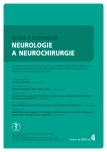The Role of MR Diffusion Weighted Imaging in the Differential Diagnosis of Spinal Cord Lesions
Authors:
M. Keřkovský 1,2; A. Šprláková-Puková 1; J. Bednařík 2,3; M. Smrčka 4; M. Mechl 1
Authors‘ workplace:
Radiologická klinika LF MU a FN Brno
1; CEITEC – Středoevropský technologický institut, MU, Brno
2; Neurologická klinika LF MU a FN Brno
3; Neurochirurgická klinika LF MU a FN Brno
4
Published in:
Cesk Slov Neurol N 2013; 76/109(4): 477-481
Category:
Short Communication
Overview
Introduction:
Diffusion weighted imaging (DWI) and diffusion tensor imaging (DTI) are magnetic resonance imaging methods, nowadays commonly used to depict the brain. Application of these methods for the spinal cord imaging is technically more demanding and less frequent. The aim of this pilot study was to summarize authors’ current experience with DWI and DTI of the spinal cord, considering the potential value for the differential diagnosis of the spinal cord lesions.
Methods:
We retrospectively evaluated DWI/ DTI findings in a group of 11 patients with pathological findings of the spinal cord on conventional MRI examination. The diagnosis comprised spinal cord ischemia, multiple sclerosis, myelitis, radiation myelopathy and arteriovenous malformations. We measured apparent diffusion coefficient (ADC) in all patients and, of the DTI data, we also measured fractional anisotropy (FA) values and evaluated the deterministic tractography reconstructions.
Results:
In four patients with spinal cord ischemia, we observed a decrease of the ADC values of the spinal cord lesions compared to the normal ‑ appearing segment within a range 36 – 61%. Small areas of restricted diffusion of the spinal cord were found also in a patient with radiation myelopathy. In two patients with spinal cord tumors, DTI tractography showed displacement and/ or disruption of the spinal cord tracts and marked decrease of the FA values (0.247 and 0.299). No abnormalities were observed on tractography in the rest of the patients, moderate decrease of the FA values was found in patients within demyelinating lesions of the spinal cord (0.494 and 0.471).
Conclusion:
DWI/ DTI of the spinal cord may contribute to the correct direction of the differential diagnostic considerations through depiction of restricted diffusion within the spinal cord ischemia and evaluation of tractography in patients with spinal cord tumors. Further research with larger numbers of patients might enable differentiation of the spinal cord lesions based on quantification of DTI parameters.
Key words:
spinal cord diseases – ischemia – diffusion magnetic resonance imaging – diffusion tensor imaging
Sources
1. Do ‑ Dai DD, Brooks MK, Goldkamp A, Erbay S, Bhadelia RA. Magnetic resonance imaging of intramedullary spinal cord lesions: a pictorial review. Curr Probl Diagn Radiol 2010; 39(4): 160 – 185.
2. Smrčka M, Šprláková A, Smrčka V, Keřkovský M. Problematika indikace operační léčby u intramedulárních lézí. Cesk Slov Neurol N 2010; 73/ 106(4): 393 – 397.
3. Holder CA, Muthupillai R, Mukundan S jr, Eastwood JD, Hudgins PA. Diffusion ‑ weighted MR imaging of the normal human spinal cord in vivo. AJNR Am J Neuroradiol 2000; 21(10): 1799 – 1806.
4. Pierpaoli C, Basser PJ. Toward a quantitative assessment of diffusion anisotropy. Magn Reson Med 1996; 36(6): 893 – 906.
5. Thurnher MM, Bammer R. Diffusion ‑ weighted MR imaging (DWI) in spinal cord ischemia. Neuroradiology 2006; 48(11): 795 – 801.
6. Ducreux D, Fillard P, Facon D, Ozanne A, Lepeintre JF, Renoux J et al. Diffusion tensor magnetic resonance imaging and fiber tracking in spinal cord lesions: current and future indications. Neuroimaging Clin N Am 2007; 17(1): 137 – 147.
7. Thurnher MM, Law M. Diffusion ‑ weighted imaging, diffusion ‑ tensor imaging, and fiber tractography of the spinal cord. Magn Reson Imaging Clin N Am 2009; 17(2): 225 – 244.
8. Loher TJ, Bassetti CL, Lövblad KO, Stepper FP, Sturzenegger M, Kiefer C et al. Diffusion ‑ weighted MRI in acute spinal cord ischaemia. Neuroradiology. 2003; 45(8): 557 – 617.
9. Keřkovský M, Šprláková ‑ Puková A, Kašpárek T, Fadrus P, Mechl M, Válek V. Diffusion tensor imaging – současné možnosti MR zobrazení bílé hmoty mozku. Cesk Slov Neurol N 2010; 73/ 106(2): 136 – 142.
10. Vargas MI, Delavelle J, Jlassi H, Rilliet B, Viallon M, Becker CD et al. Clinical applications of diffusion tensor tractography of the spinal cord. Neuroradiology 2008; 50(1): 25 – 29.
Labels
Paediatric neurology Neurosurgery NeurologyArticle was published in
Czech and Slovak Neurology and Neurosurgery

2013 Issue 4
Most read in this issue
- Difficulties Diagnosing Progressive Multifocal Leukoencephalopathy in Patients Infected with the Human Immunodeficiency Virus – Case Reports
- Skull Base Surgery
- Neuropsychiatric View of Huntington‘s Disease
- Validation of the Slovak version of the Movement Disorder Society – Unified Parkinson’s Disease Rating Scale (MDS‑ UPDRS)
